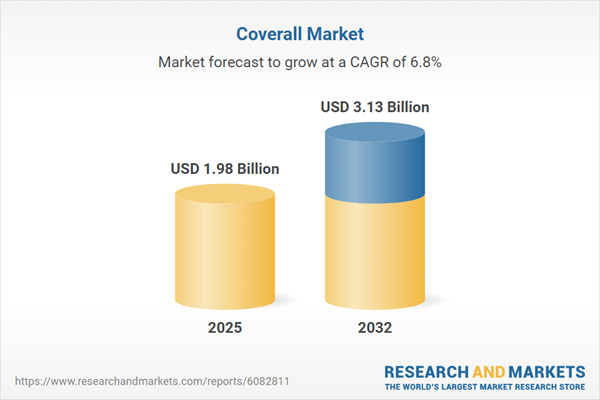Speak directly to the analyst to clarify any post sales queries you may have.
The global coverall market represents a vital segment within protective apparel, supporting occupational health, compliance, and operational resilience for organizations operating in high-risk and regulated sectors. As industry standards evolve, senior leaders now view coveralls as integral to both workforce safety and sustainable business strategy.
Market Snapshot: Coverall Market Size and Growth Outlook
The Coverall Market is experiencing consistent expansion, growing from USD 1.85 billion in 2024 to USD 1.98 billion in 2025, with forecasts pointing toward USD 3.13 billion by 2032. This growth, measured at a CAGR of 6.76%, reflects a robust demand for dependable personal protective equipment across diverse industries. Ongoing innovation, strict regulatory frameworks, and stronger emphasis on operational efficiency are key factors shaping the market’s momentum. Both suppliers and end-users are responding to evolving risk management priorities and a heightened focus on compliance through steady investments and enhanced procurement strategies.
Scope & Segmentation of the Global Coverall Market
This comprehensive analysis outlines the distinct sectors, technologies, and business models underpinning the global coverall market. Senior decision-makers can use these insights to prioritize capital allocation and adapt sourcing approaches with precision.
- Type: Disposable and reusable options, covering variants differentiated by construction materials such as polypropylene, SMS (single-layer and triple-layer), cotton, and polyamide to accommodate a wide spectrum of workplace risks and hygiene protocols.
- Material: Polyethylene (high and low density), polypropylene, and SMS each offer unique advantages in durability, breathability, and chemical resistance, helping buyers align product selection with both safety objectives and long-term cost management.
- End User: Construction, healthcare, industrial, and oil and gas segments, including applications spanning infrastructure, commercial, and residential projects; settings such as hospitals, laboratories, automotive, chemical processing, and manufacturing units; as well as key phases in the oil and gas value chain.
- Distribution Channel: Direct B2B sales, national and global distributors, government contracts, digital sales channels including company websites and online marketplaces, plus specialized safety equipment outlets and uniform suppliers facilitate adaptable procurement for enterprise and institutional buyers.
- Regional Coverage: Americas (covering both North and Latin America), Europe, the Middle East and Africa, and Asia-Pacific, each reflecting regional policy drivers, workforce demands, technological ecosystems, and procurement practices that influence market engagement.
- Company Coverage: Key participants, such as Compass Group PLC, CBRE Group, Inc., Sodexo S.A., Jones Lang LaSalle Incorporated, Aramark Corporation, Ecolab Inc., ISS A/S, Cintas Corporation, ABM Industries Incorporated, and GDI Integrated Facility Services Inc., provide end-to-end capabilities from sourcing to service management, ensuring broad geographic reach and diverse market coverage.
Key Takeaways for Senior Decision-Makers
- Material science advances are setting new industry benchmarks for comfort and protection, prompting procurement teams to focus on fabric innovations that boost user productivity in demanding environments.
- Tightened regulatory standards are accelerating the adoption of new textile technologies and ergonomic designs that balance evolving compliance requirements with sustainability objectives.
- Enterprises are elevating supply chain resilience through real-time tracking solutions, predictive analytics, and near-shoring to mitigate volatility and avoid inventory shortages.
- Organizational environmental responsibility is driving a transition towards reusable and hybrid fabric coveralls, allowing cost optimization over complete product lifecycles and supporting green policies.
- Digital transformation—including RFID tracking and automated compliance monitoring—is improving transparency, operational oversight, and positioning organizations for future regulatory changes.
- Geographic market strategies are adapting quickly in Asia-Pacific and Latin America, leveraging regional manufacturing and infrastructure investments to address unique local demands and accelerate market penetration.
Tariff Impact: Navigating Trade Policy Shifts
Recent tariff changes in the United States, especially on essential coverall materials like polypropylene and polyethylene, are prompting a reassessment of supply chain strategies. Producers are broadening their supplier networks and expanding regional manufacturing to limit exposure to cost fluctuations and potential disruptions. These actions include sourcing alternative materials, reinforcing procurement flexibility, and deepening near-shoring arrangements—a critical step for maintaining pricing stability and business continuity in an evolving trade context.
Methodology & Data Sources
This report is grounded in a blend of primary and secondary research, drawing on trade publications, patent records, and targeted interviews with manufacturers, distributors, procurement leaders, and safety officers. Market data is validated using triangulation and scenario analysis to ensure a high level of accuracy in trend forecasting and policy impact assessment.
Why This Report Matters: Strategic Value for Senior Leaders
- Enables evidence-based decision-making in investment, sourcing, and product strategies through detailed market segmentation and region-specific insights.
- Prepares leaders to proactively respond to changing regulations, technology progress, and elevated sustainability expectations in protective apparel and connected supply chains.
- Supports competitive positioning by aligning operational, digital, and procurement plans with evolving enterprise requirements and regional dynamics.
Conclusion
The coverall market is progressing as safety, sustainability, and operational efficiency take on new significance. Organizations that monitor these developments are well positioned to navigate market challenges and leverage new value opportunities in workforce protection.
Table of Contents
3. Executive Summary
4. Market Overview
7. Cumulative Impact of Artificial Intelligence 2025
Companies Mentioned
The companies profiled in this Coverall market report include:- Compass Group PLC
- CBRE Group, Inc.
- Sodexo S.A.
- Jones Lang LaSalle Incorporated
- Aramark Corporation
- Ecolab Inc.
- ISS A/S
- Cintas Corporation
- ABM Industries Incorporated
- GDI Integrated Facility Services Inc.
Table Information
| Report Attribute | Details |
|---|---|
| No. of Pages | 197 |
| Published | November 2025 |
| Forecast Period | 2025 - 2032 |
| Estimated Market Value ( USD | $ 1.98 Billion |
| Forecasted Market Value ( USD | $ 3.13 Billion |
| Compound Annual Growth Rate | 6.7% |
| Regions Covered | Global |
| No. of Companies Mentioned | 11 |









